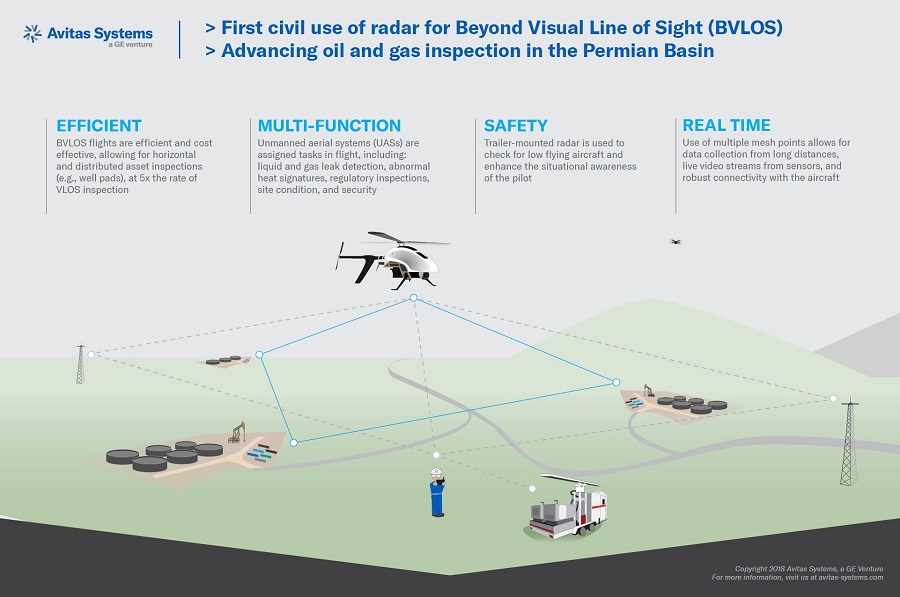GE's Avitas Gains First BLVOS Approval after Shell Oil Study
Avitas Systems, a GE venture, has received Federal Aviation Administration (FAA) approval to fly an unmanned aerial system (UAS) beyond visual line of sight (BVLOS) in Loving County, Texas. The permission authorizes Avitas Systems to fly a UAS over 55 pounds at low altitudes without a visual observer for industrial inspection; it is the first FAA-approved civil use of BVLOS with radar.
The approval marks an important step toward long-range pipeline monitoring using drones. It followed a successful study with Shell Oil to demonstrate how the technology can improve industrial operational efficiency and safety.
Currently, regulations require UAS to stay within range of the pilot’s vision. The FAA’s permission allows Avitas Systems to use a radar system and enhanced operational procedures to provide an equivalent level of safety. Avitas said the extended range of BVLOS operations allows for safer, and more efficient monitoring of critical industrial infrastructure and, when combined with advanced analytics, enables more accurate and efficient monitoring, detection and repair of leaks.
“Drones are already an integral part of Shell’s digital operations, with missions flown daily across our global footprint. Now, with the FAA’s approval and with the assistance of Avitas Systems, we can fly over a larger area of our Permian Basin operations to conduct aerial monitoring of our oil and gas infrastructure," said said Bruce Culpepper, U.S. country chair for Shell.
"This includes leak detection and data gathering needed to make more efficient operational decisions, which will result in improved environmental performance with less strain on road infrastructure in the Permian Basin" Culpepper added.
“Being the first FAA-approved civil use of BVLOS with radar is a significant achievement for Avitas Systems and our customers,” said Brad Tomer, Interim CEO for Avitas Systems. “We worked closely with Shell Oil Company for the use case, location, and to show how this technology can improve industrial operational efficiency and safety. The FAA provided the necessary feedback to enable our team to design a system that safely meets the aviation regulatory requirements.”
BVLOS flight enables data collection in difficult, hard-to-reach places. Avitas Systems integrates "pilot-in-the-loop" safety measures, using trailer-mounted radar, to ensure enhanced situational awareness during flights. The UAS use robust data links, Avitas said, so their sensors upload live streams of inspection data in real time for review and analysis while safely controlling the flight operation.
“We received the FAA’s permission due to our systematic approach of using airspace management with a unique combination of proven UAS radar and communications technologies, which demonstrate that safety is our top priority,” said Michael Clatworthy, Director of Flight Operations for Avitas Systems. “This is the first step in our approach to larger-scale BVLOS inspection operations.”
Related News
Related News

- Kinder Morgan Proposes 290-Mile Gas Pipeline Expansion Spanning Three States
- Three Killed, Two Injured in Accident at LNG Construction Site in Texas
- Tallgrass to Build New Permian-to-Rockies Pipeline, Targets 2028 Startup with 2.4 Bcf Capacity
- TC Energy Approves $900 Million Northwoods Pipeline Expansion for U.S. Midwest
- U.S. Moves to Block Enterprise Products’ Exports to China Over Security Risk
- U.S. Pipeline Expansion to Add 99 Bcf/d, Mostly for LNG Export, Report Finds
- Enbridge Adds Turboexpanders at Pipeline Sites to Power Data Centers in Canada, Pennsylvania
- Great Basin Gas Expansion Draws Strong Shipper Demand in Northern Nevada
- Cheniere Seeks FERC Approval to Expand Sabine Pass LNG Facility
- Heath Consultants Exits Locate Business to Expand Methane Leak Detection Portfolio





Comments